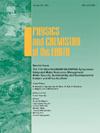Remote sensing analysis and geodynamic setting of magmatic spessartine-almandine-bearing leucogranites, Um Addebaa area, southeastern Desert, Egypt: Bulk rock and mineral chemistry
IF 3
3区 地球科学
Q2 GEOSCIENCES, MULTIDISCIPLINARY
引用次数: 0
Abstract
This study aims to incorporate optical multispectral remote sensing, petrography, geochemical, and field investigations in producing mapping and surface abundance of garnet mineralization within Um Addebaa area, southeastern Desert of Egypt. Datasets of Landsat-8 OLI/TIRS, ASTER, and Sentinel-2A (S2A) were handled and scaled enhanced to discriminate the units of lithologic rock and garnet mineralization. The spectral mapping techniques of constrained energy minimization (CEM) and matched filtering (MF) are used to detect the garnet-rich zones, which are confined to the leucogranites masses. These granites are spessartine-almandine-rich, certainly along the zone of interaction with the ophiolitic mélange. Notably, they have high total alkalis, SiO2, and Al2O3, Rb, 104Ga/Al, Y, Zr, Pb, Rb/Sr, Al2O3/TiO2, and FeO/MgO, and strong Ti, Sr, and Ba depletion as well as low CaO/Na2O ratio (<0.3). These geochemical parameters reflect their calc-alkaline nature, and strongly peraluminous S-type magma composition. They are derived by two episodes of partial melting clay-rich metapelite crustal rocks followed by extreme Fe–Ti oxides and feldspar fractionation. These leucogranites formed within an extension tectonic regime during a post-collisional episode, resulting in raising of the asthenosphere and partial melting of the crustal metasedimentary rocks. Garnet occurs as aggregates and/or vein like-shape, subhedral to rounded grains, homogeneous and rarely reveal weak zonation. It's cracked and free of inclusions. It contains appreciatable concentrations of FeO and MnO and minor amounts of CaO and MgO, dominantly spessartine-almandine end-member (Alm52-59Sps 31-36 Grs 8-12 Prp0.5-0.8 Adr0). Garnet chemical compositions reflect its magmatic origin with MnO–FeO-bearing magma that is produced from in situ nucleation from strongly peraluminous magmas in a post-collision geotectonic setting.
埃及东南部沙漠 Um Addebaa 地区岩浆锰铝榴石的遥感分析和地球动力环境:岩体和矿物化学
本研究旨在结合光学多光谱遥感、岩石学、地球化学和实地调查,绘制埃及东南部沙漠 Um Addebaa 地区的石榴石矿化图并确定其地表丰度。对 Landsat-8 OLI/TIRS、ASTER 和 Sentinel-2A (S2A) 数据集进行了处理和比例增强,以区分岩性岩石和石榴石矿化单元。利用约束能量最小化(CEM)和匹配滤波(MF)的光谱制图技术来探测富含石榴石的区域,这些区域仅限于白榴石岩块。这些花岗岩富含锰铝榴石,当然是沿着与蛇绿混杂岩相互作用的区域。值得注意的是,它们具有较高的总碱、SiO2、Al2O3、Rb、104Ga/Al、Y、Zr、Pb、Rb/Sr、Al2O3/TiO2 和 FeO/MgO,以及较强的 Ti、Sr 和 Ba 贫化和较低的 CaO/Na2O 比率(<0.3)。这些地球化学参数反映了它们的钙碱性和强过铝 S 型岩浆成分。它们是在富含粘土的玄武岩地壳岩石部分熔融后,经过两次极端的铁钛氧化物和长石分馏过程而形成的。这些白榴石是在碰撞后的延伸构造体系中形成的,碰撞导致星体层上升,地壳玄武岩部分熔化。石榴石呈集合体和/或脉状,近球形至圆形颗粒,均质,很少显露弱分带。石榴石呈裂纹状,不含包裹体。它含有可观浓度的氧化铁和氧化锰以及少量的氧化钙和氧化镁,主要成分为锰铝榴石末段(Alm52-59Sps 31-36 Grs 8-12 Prp0.5-0.8 Adr0)。石榴石的化学成分反映了其岩浆来源,即在碰撞后的大地构造环境中,由强过铝岩浆原地成核产生的含氧化锰-氧化铁的岩浆。
本文章由计算机程序翻译,如有差异,请以英文原文为准。
求助全文
约1分钟内获得全文
求助全文
来源期刊

Physics and Chemistry of the Earth
地学-地球科学综合
CiteScore
5.40
自引率
2.70%
发文量
176
审稿时长
31.6 weeks
期刊介绍:
Physics and Chemistry of the Earth is an international interdisciplinary journal for the rapid publication of collections of refereed communications in separate thematic issues, either stemming from scientific meetings, or, especially compiled for the occasion. There is no restriction on the length of articles published in the journal. Physics and Chemistry of the Earth incorporates the separate Parts A, B and C which existed until the end of 2001.
Please note: the Editors are unable to consider submissions that are not invited or linked to a thematic issue. Please do not submit unsolicited papers.
The journal covers the following subject areas:
-Solid Earth and Geodesy:
(geology, geochemistry, tectonophysics, seismology, volcanology, palaeomagnetism and rock magnetism, electromagnetism and potential fields, marine and environmental geosciences as well as geodesy).
-Hydrology, Oceans and Atmosphere:
(hydrology and water resources research, engineering and management, oceanography and oceanic chemistry, shelf, sea, lake and river sciences, meteorology and atmospheric sciences incl. chemistry as well as climatology and glaciology).
-Solar-Terrestrial and Planetary Science:
(solar, heliospheric and solar-planetary sciences, geology, geophysics and atmospheric sciences of planets, satellites and small bodies as well as cosmochemistry and exobiology).
 求助内容:
求助内容: 应助结果提醒方式:
应助结果提醒方式:


